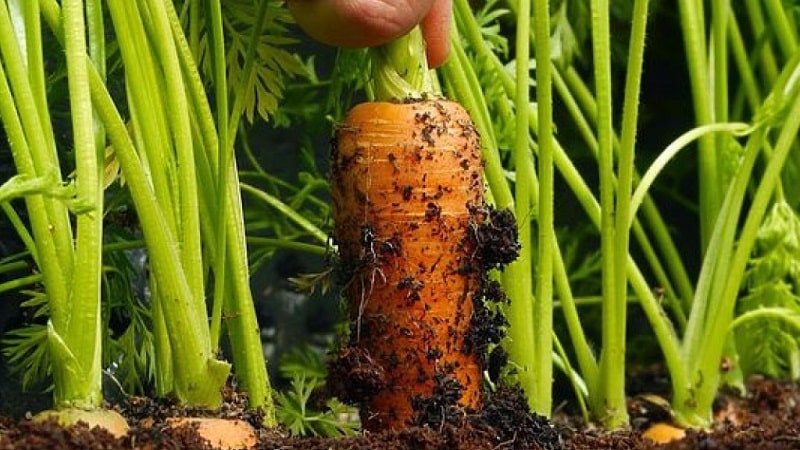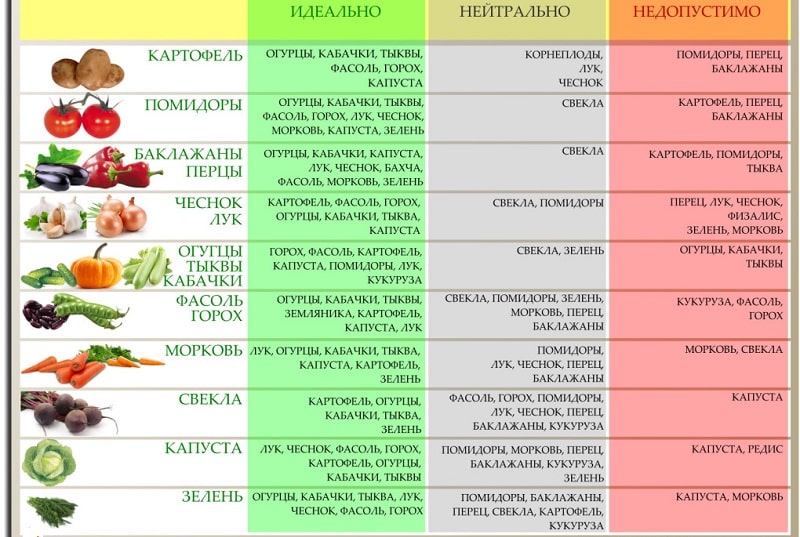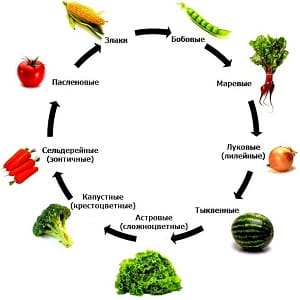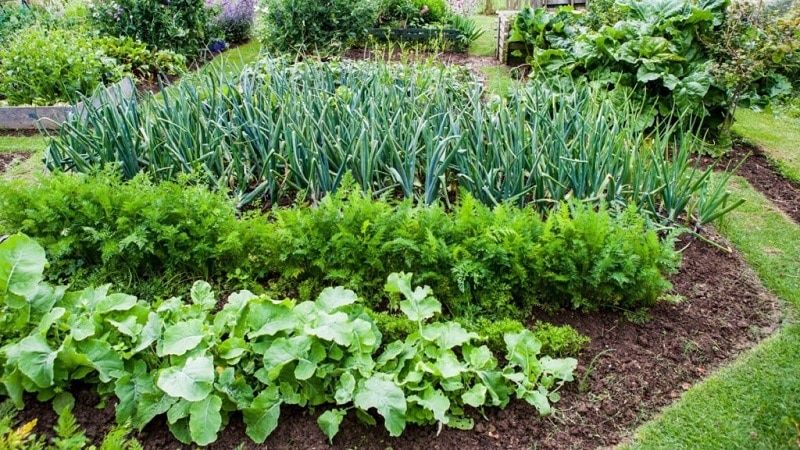The basics of crop rotation from experienced summer residents: what can be planted after carrots next year
A rich harvest of vegetables largely depends on the correct proximity and rotation of crops on the site. Thanks to proper crop rotation, you can effectively “pump up” the soil on your site and even reduce the number of weeds.
Read our article about when it is better to plant carrots and what to plant after them, which plants to plant nearby and which ones further away.
Why is it important to follow the rules of crop rotation?
If you neglect crop rotation, you can lose a significant part of the harvest. It is necessary to plant vegetables according to his rules for the following reasons::
- When growing one type of crop, the same pathogens and pests accumulate in the soil, which requires additional treatment of the plants.
- The same vegetable crops absorb certain nutrients from the soil. Sucking out the same microelements greatly depletes the earth. The problem is solved by applying mineral and organic fertilizers, which will require material costs.
- If crop rotation rules are not followed, toxic substances (viburnum) accumulate in the soil and are released by plant roots. And if vegetables are grown in the same place for several years in a row, then the concentration of harmful compounds will be exceeded and will have a depressing effect on the planted crops.

Besides, Following the rules of alternating vegetables will reduce the number of weeds and prevent soil depletion.
Crop rotation of carrots in greenhouses and open ground
In greenhouses, it is difficult to maintain crop rotation rules due to the saving of usable space and energy consumption. Carrots get along well with tomatoes, garlic, cucumbers and onions. In greenhouses it is used as the main crop, and onions as an additional crop.
Carrots are most often grown in open ground. This the vegetable is highly susceptible to its own toxins released during growth. It is recommended to re-grow it on the site only after 4-5 years.
Green manure is used to improve soil health. The pattern of alternating vegetables after carrots is as follows: in the first year - sowing green manure crops, in the second year - cabbage or cucumbers, in the third - green manure again, in the fourth - onions.
The note! Green manures include mustard, legumes, vetch, rapeseed, alfalfa, clover, lupine, oats, buckwheat, and radish. They contain large quantities of microelements important for plants (nitrogen, potassium and phosphorus), as well as proteins, sugars, and starch. When grown, their root system normalizes the soil structure.
What is best to plant after carrots next year?
Carrots greatly deplete the soil. It takes a lot of potassium and phosphorus from the ground: 4 times more than tomatoes, and 3 times more than cucumbers. Planting these vegetables with the addition of organic and mineral fertilizers will restore the balance of nutrients in the soil.
These plants also include:
- various varieties of pepper;
- cabbage, early radish, lettuce and mustard;
- legumes (beans, peas, beans);
- nightshades (tomatoes, potatoes, eggplants, physalis, sweet potatoes);
- artichokes ensuring good drainage.
It is advisable to plant vegetables with a shallow root system. and “above-ground” harvest.

What should not be planted?
Of course, you can’t plant carrots themselves.
They won't grow well:
- beet;
- melons (watermelons, pumpkins, squash, melons, zucchini);
- greens and herbs;
- celery, chard and spinach;
- onion and garlic.
Interesting on the topic:
Is it possible to plant garlic and onions after carrots for the winter?
It is not advisable to sow onions and garlic after harvesting carrots.. Root crops deplete the soil and the soil needs to be allowed to rest. The best option is green manure plants.
What is the best way to grow carrots?
Carrots are sensitive to soil components and fertilizers contained in it.. It’s good if its predecessors are cucumbers, onions, tomatoes, and potatoes. Alternating with these vegetables helps preserve the quality of the soil and the necessary components for nutrition.
 Suitable predecessors:
Suitable predecessors:
- nightshades (potatoes, tomatoes and physalis);
- pumpkin, cucumbers, zucchini, watermelons;
- cabbage, onion and garlic;
- spicy herbs (basil, tarragon);
- green herbs (spinach, chard);
- legumes (peas, beans, beans).
Bad predecessors for carrots
Undesirable plants include parsley, cumin, dill and celery. They have a lot in common: diseases, pests and nutrients consumed. It is not recommended to sow after sunflowers and eggplants.
Read also:
What to plant after pumpkin next year
What to plant nearby
When planning plantings in the garden, pay attention to the compatibility of different plants. They can either support each other or oppress each other.
An example of beneficial coexistence is carrots and onions.Both plants are often affected by onion and carrot flies, respectively. The carrot fly cannot tolerate the smell of onions, and the onion fly cannot tolerate the smell of carrots. Therefore, by planting vegetables in one bed, you can grow an excellent harvest of both. Instead of onions, you can plant garlic.
Important! Be sure to grow onions and carrots side by side.
They get along well with carrots:
- legumes (peas, beans) make the soil loose and enrich it with nitrogen;
- lettuce – it helps retain moisture;
- spinach, tomatoes, radishes, cabbage, radishes, beets;
- various herbs.
Unfavorable neighborhood
Can't be grown nearby cabbage, cucumbers and fennel, as well as dill, celery and other umbelliferous – they attract common pests.
Important! Carrots don't like being around weeds. Plant in a weed-free area.

Advice from experienced gardeners
Based on classical techniques, many experienced gardeners give useful recommendations:
- In the beds after the carrots, it is good to plant strawberry and wild strawberry bushes.
- To protect against carrot flies, it is advisable to plant calendula or marigolds along the perimeter of the bed, and use alternating rows of onions and carrots.
- Experienced vegetable growers advise planting carrots after beans.
- It is recommended to exclude salad as a precursor due to the same diseases.
- A good neighbor is the leek.
- You can’t sow the root crop after sweet pepper; the taste may change.
- You can grow beets next to carrots; they protect against diseases.
- Carrot beds should not be placed next to an apple tree; the taste of both plants will deteriorate.
- The root crop does not grow well in soil saturated with manure; it is better to plant potatoes, cabbage, and cucumbers in such beds. And next year - carrots.
- If parsley grew on the site, then it is strictly forbidden to plant carrots in this place. When there is no other area, dig up the soil and treat it with potassium permanganate.
- Perennial berry bushes can be planted in carrot beds.
Conclusion
The rules of crop rotation are simple; even a novice gardener can easily understand them. By following these rules and taking into account the advice of experienced vegetable growers, you will reap an excellent carrot harvest. Good luck to everyone at the dachas!